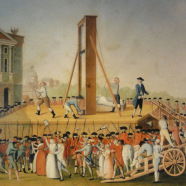
Word of the Day: Wistful
Today’s Word of the Day, thanks to the Word Genius website, is wistful. Wistful, according to Word Genius, means “Having or showing a feeling of vague or regretful longing.” According to www.dictionary.com, it means “characterized by melancholy; longing; yearning” or “pensive, especially in a melancholy way.” One interesting fact about the word is that, over the course of 100 years of so, it changed meaning pretty substantially, at least according to www.etymonline.com: “1610s, ‘closely attentive,’ perhaps from obsolete wistly ‘intently’ (c. 1500), of uncertain origin. Perhaps formed on the model of wishful. Middle English wistful meant ‘bountiful, well-supplied,’ from Old English wist ‘provisions.’ The meaning of ‘longingly pensive, musing’ is by 1714.”
How did a word meaning “closely attentive” come to mean “regretful” over the course of 100 years?
Here’s a possibility. This in the entry at www.etymonline.com for the archaic word wist: “’to know’ (archaic), c. 1500, from Old English past tense of witan ‘to know’ (cognate with German wusste, past tense of wissen ‘to know’); see wit. Had-I-wiste was used c. 1400-1550 in sense ‘regret for something done rashly or heedlessly;’ see wist. Proverbial in expression Had-I-wiste cometh ever too late.
Haddywyst comyth euer to late Whan lewyd woordis beth owte y-spronge. [‘Commonplace book’ in Trinity College, Cambridge, c. 1500].” So the meaning of wistful may very well come from the expression, “had I known,” as in “if only I had known.”
On this date in 1792, Nicolas Jacques Pelletier breathed his last. Pelletier was a highwayman, a robber, and perhaps a murderer.
Little is known of Pelletier. But we do know that on October 14, 1791, Pelletier and some of his associates attacked a man in the Bourbon-Villeneuve in Paris. They took his wallet and other valuables. And in the course of the attack, someone killed the man. Nicolas Pelletier was caught that same night and accused of the murder as well as of the robbery. Despite his putting up a defense, he was convicted and sentenced to be executed on December 31, 1791. An appeal to a second court proved fruitless for Pelletier.
And then Pelletier caught a little bit of a break.
The Legislative Assembly declared that the only acceptable method of execution was beheading. But the French, who were now attempting a “constitutional monarchy” (Louis XVI was not executed until January of 1793). But the objection to the Ancien Régime (the “old rule”) was such that the revolutionaries were uncomfortable with the traditional means of beheading a prisoner—hacking off the head with a sword or axe, a process which generally took at least two chops.
So at this time, the French republic was waiting for Tobias Schmidt and Antoine Louis (oddly enough the king’s physician) to develop a machine for humanely and swiftly beheading a convict. The machine they developed was named for neither of them but rather for the physician and politician who called for this more humane form of execution–Dr. Joseph-Ignace Guillotin. Actually, Dr. Guillotine opposed the death penalty completely, but a more humane form of execution was the next best option. Keep in mind that, along with beheading, the authorities in the early modern period used hanging and breaking at the wheel, the latter being a form of torture and execution.
Pelletier waited for almost four full months, but finally, it was ready, and on April 25, 1792, he was led to the Hôtel de Ville in the Place de Grève, what had been the place for public executions for decades. A large crowd had gathered, and soldiers from the National Guard were present for crowd control. At about 3:30, Pelletier, wearing a red shirt, was led up to the guillotine, which sat on a scaffold, perhaps because of tradition or perhaps so that the crowd could see better. The guillotine was painted red, matching Pelletier’s shirt. And with the drop of the blade, Nicolas Jacques Pelletier died.
The crowd was displeased because it happened so quickly. They were used to seeing a man tortured on the wheel or at least getting to watch his legs kick or perhaps watching the executioner struggle with a second, third, or fourth chop before getting the head off. But the guillotine was humane and effective, at least for a means of execution. According to Jeffrey Abbott (What a Way to Go [2007], p. 144), the people called out for a return to hanging.
While Pelletier was the first, he was not the last. During the time of the Legislative Assembly, 28 more people were executed using La Madame Guillotine. But then, in 1793, the Reign of Terror began. It was initiated by Bertrand Barère de Vieuzac, Maximilien François Marie Isidore de Robespierre, and other members of the National Convention, and during its time, over 16,000 French citizens were executed. Robespierre justified the Reign of Terror this way:
If the basis of popular government in peacetime is virtue, the basis of popular government during a revolution is both virtue and terror; virtue, without which terror is baneful; terror, without which virtue is powerless. Terror is nothing more than speedy, severe and inflexible justice; it is thus an emanation of virtue; it is less a principle in itself, than a consequence of the general principle of democracy, applied to the most pressing needs of the patrie.
It wasn’t until the fall of Robespierre on July 27, 1794, that the guillotine’s work was mostly done. But by the beginning of the Thermidorian Reaction, a wistful attitude was not enough. Sadly, one can see even today a fondness among some radicals for the extremist measures of the Reign of Terror. I guess the old saying is true: those who do not know their history are condemned to repeat it.
The picture is an illustration of the guillotine execution of Eugen Weidmann in Versailled on June 17, 1939, the last public execution by guillotine, though the guillotine would continue to be used until 1977.